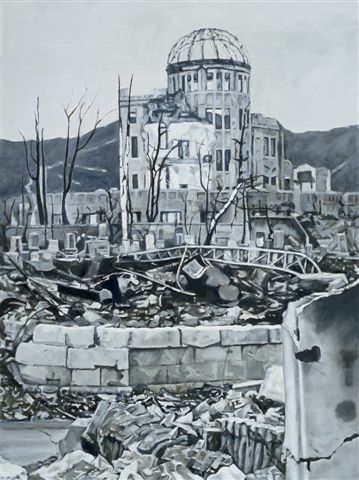Why World War II ended with Mushroom Clouds
65 years ago, August 6 and 9, 1945: Hiroshima and Nagasaki

The Hiroshima Peace Memorial (Genbaku Dome) was the only structure left standing in the area where the first atomic bomb exploded on 6 August 1945. Through the efforts of many people, including those of the city of Hiroshima, it has been preserved in the same state as immediately after the bombing.
by Jacques R. Pauwels, Global Research, August 6, 2010
On Monday, August 6, 1945, at 8:15 AM, the nuclear bomb ‘Little Boy” was dropped on Hiroshima by an American B-29 bomber, the Enola Gay, directly killing an estimated 80,000 people. By the end of the year, injury and radiation brought total casualties to 90,000-140,000.[1]
On August 9, 1945, Nagasaki was the target of the world’s second atomic bomb attack at 11:02 a.m., when the north of the city was destroyed and an estimated 40,000 people were killed by the bomb nicknamed ‘Fat Man.’ The death toll from the atomic bombing totalled 73,884, as well as another 74,909 injured, and another several hundred thousand diseased and dying due to fallout and other illness caused by radiation.[2]
In the European Theatre, World War II ended in early May 1945 with the capitulation of Nazi Germany. The “Big Three” on the side of the victors – Great Britain, the United States, and the Soviet Union – now faced the complex problem of the postwar reorganization of Europe. The United States had entered the war rather late, in December 1941, and had only started to make a truly significant military contribution to the Allied victory over Germany with the landings in Normandy in June 1944, less than one year before the end of the hostilities. When the war against Germany ended, however, Washington sat firmly and confidently at the table of the victors, determined to achieve what might be called its “war aims.”
As the country that had made the biggest contribution and suffered by far the greatest losses in the conflict against the common Nazi enemy, the Soviet Union wanted major reparation payments from Germany and security against potential future aggression, in the form of the installation in Germany, Poland and other Eastern European countries of governments that would not be hostile to the Soviets, as had been the case before the war. Moscow also expected compensation for territorial losses suffered by the Soviet Union at the time of the Revolution and the Civil War, and finally, the Soviets expected that, with the terrible ordeal of the war behind them, they would be able to resume work on the project of constructing a socialist society. The American and British leaders knew these Soviet aims and had explicitly or implicitly recognized their legitimacy, for example at the conferences of the Big Three in Tehran and Yalta. That did not mean that Washington and London were enthusiastic about the fact that the Soviet Union was to reap these rewards for its war efforts; and there undoubtedly lurked a potential conflict with Washington’s own major objective, namely, the creation of an “open door” for US exports and investments in Western Europe, in defeated Germany, and also in Central and Eastern Europe, liberated by the Soviet Union. In any event, American political and industrial leaders – including Harry Truman, who succeeded Franklin D. Roosevelt as President in the spring of 1945 – had little understanding, and even less sympathy, for even the most basic expectations of the Soviets. These leaders abhorred the thought that the Soviet Union might receive considerable reparations from Germany, because such a bloodletting would eliminate Germany as a potentially extremely profitable market for US exports and investments. Instead, reparations would enable the Soviets to resume work, possibly successfully, on the project of a communist society, a “counter system” to the international capitalist system of which the USA had become the great champion. America’s political and economic elite was undoubtedly also keenly aware that German reparations to the Soviets implied that the German branch plants of US corporations such as Ford and GM, which had produced all sorts of weapons for the Nazis during the war (and made a lot of money in the process[3]) would have to produce for the benefit of the Soviets instead of continuing to enrich US owners and shareholders.
Article continues . . .

